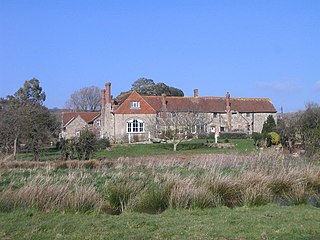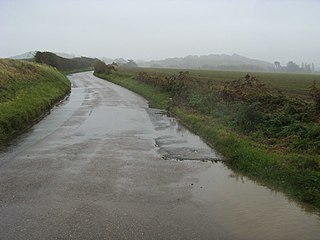Related Research Articles

Arreton is a village and civil parish in the central eastern part of the Isle of Wight, England. It is about 3 miles south east of Newport.

Hordle is a village and civil parish in the county of Hampshire, England. It is situated between the Solent coast and the New Forest, and is bordered by the towns of Lymington and New Milton. Like many New Forest parishes Hordle has no village centre. The civil parish includes the hamlets of Tiptoe and Everton as well as part of Downton. The parish was originally much larger; stretching from the New Forest boundary to Hurst Castle.

Haseley Manor is a 14th-century, Grade 2* listed property located in Arreton on the Isle of Wight.

The Great Budbridge Manor is a manor house just south of Merstone, near Arreton, Isle of Wight, England. Fish ponds on the grounds appear medieval.

Apse Manor is a manor house on the Isle of Wight, situated just within the eastern boundary of the Newchurch parish. The house is pleasantly situated just to the north of the high road from Shanklin and as of 1912 retained a room with a stone fireplace and a heavy panelled Tudor ceiling.
Ashey Manor is a manor house in Ashey on the Isle of Wight, situated within the Newchurch parish. It was historically linked with Ryde Manor.
Cleaveland Manor is a manor house on the Isle of Wight, situated within the Victoria parish.

Wolverton Manor is a manor house in Shorwell, on the Isle of Wight, England. The original house was started by John Dingley, Deputy Governor of the Isle of Wight. The Jacobean style home, built by Sir John Hammond after the death of Sir John Dingley, is the second house built on the site. There is a two-storey porch which features a flat roof and hollow angle columns.
Hale Manor is a manor house on the Isle of Wight, situated in the parish of Arreton. It forms the south-eastern portion of the parish adjoining Newchurch, and comprises the high ground to the south of the River Yar above Horringford.
Huffingford Manor is a manor house on the Isle of Wight, situated in the parish of Arreton.
Rookley Manor is a manor house on the Isle of Wight, situated in the parish of Arreton. Though originally in Godshill parish, it is now included for the greater part in the boundaries of South Arreton.
Adgestone Manor is a manor house in Brading on the Isle of Wight.
Alverstone Manor is a manor house in Alverstone in the parish of Brading on the Isle of Wight.
Barnsley Manor is a manor house in the parish of Brading on the Isle of Wight.
Milton Manor is a manor house in the parish of Brading on the Isle of Wight, in England.
Borthwood Manor is a manor house in the parish of Brading on the Isle of Wight.
Grove Manor is a manor house in the parish of Brading on the Isle of Wight in England.
Durton Manor was a manor house on the Isle of Wight, situated in the parish of Arreton.
Redway Manor is a manor house on the Isle of Wight, situated in the parish of Arreton.

Rookley Manor is a Grade II* listed country house, located in Up Somborne in Hampshire, England.
References
This article includes text incorporated from William Page's "A History of the County of Hampshire: Volume 5 (1912)", a publication now in the public domain